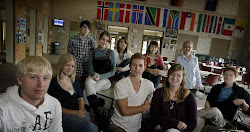Due to the massive amount of public interest in the Cop15 negotiations a much larger crowd than anyone had originally anticipated arrived at the Bella center this morning to hear speeches from many of the worlds most powerful leaders. Party members and press were giving additional credentials to attend this mornings sessions; however only ninety of twenty two thousand Non-governmental accredited observers (NGOs) were given the additional pass needed to enter the conference today. This unforeseen event allowed the other SESEF delegates and myself the chance to experience what else was happening in Copenhagen away from the Bella Center. I used this opportunity to surround myself in the interactive atmosphere of Denmark's National Museum. One of the most fascinating exhibits was dedicated entirely to indigenous people from all different parts of the world. The exhibit was divided into sections and each section contained information and artifacts on the indigenous people from one country or a specific area of the world.
All of the cultures featured in the exhibit were under the threat of westernization or had already disappeared entirely from the earth. One section in particular caught my attention as one of the most endangered groups of people on the planet. The native pacific islanders are a group of people we heard a great deal about and from at the COP 15 conference. Because of rising sea levels due to climate change they are being forced to leave their native lands. More specifically, their land is slowly disappearing. Cultures are shaped around their environment; if you take away the environment you take away the culture. The exhibit could only offer brief snapshots of entire groups of people who had already disappeared forever. I can only wonder how many more cultures will be added to this exhibit in the next century.


No comments:
Post a Comment